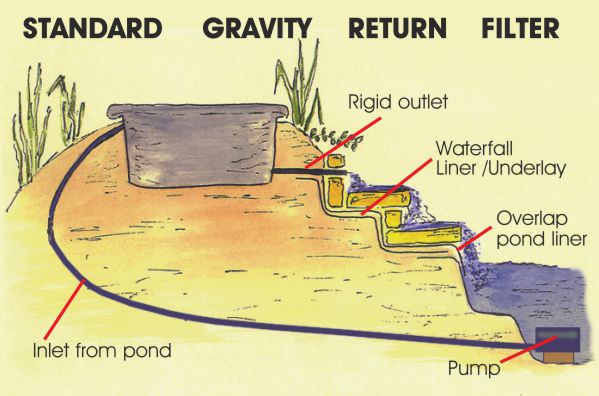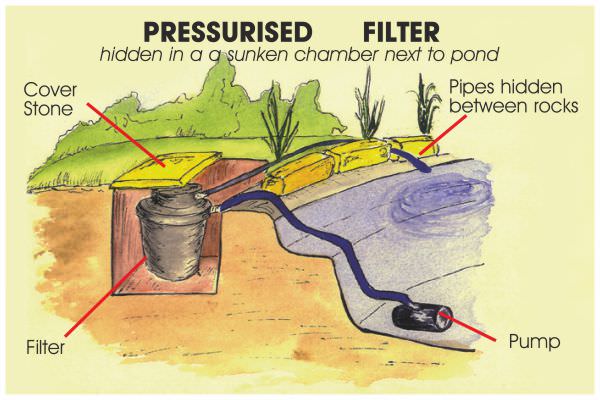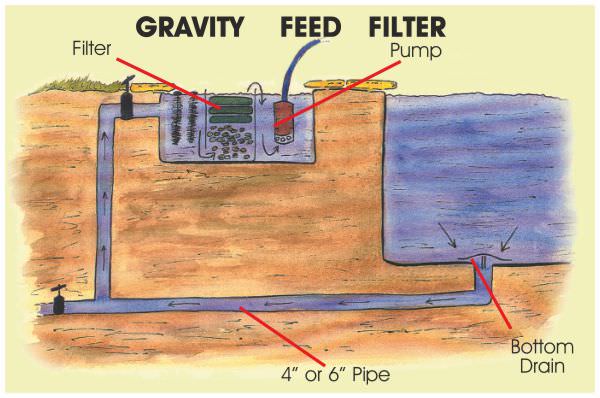
There are two main types of successful pond filtration. An Ultra Violet Clarifier filter kills green water to keep the water clear, while a Biological Filter looks after the water quality to keep the fish healthy and happy. Most modern filters combine these methods into one unit for convenience and ease of installation.
Do All Ponds Need Filtration?
No. If you are intending not to have any fish, or you’re creating a wildlife pond with high plant stocks and just a few fish you may choose not to have a filter, and try to create a natural balance instead.
It is a relatively simple process but can take a very long time to get a balanced nitrogen cycle within your pond, hence why most people still opt for a filter of some kind.
The principle is very simple. You will need plenty of plants, probably covering two thirds of the pond area. These plants, along with naturally occurring helpful bacteria in the pond, will then use and digest any toxins left by fish and rotting organic waste, hopefully providing a good natural balance and a clear pond. It is important to remember that the plants should be well established before gradually introducing fish, and it could take at least eighteen months to create a naturally balanced pond.
Biological Filtration
Most beginners believe a pond filter works by removing physical dirt and it is this which keeps the water sparkling clean.
In fact this is not the case, although a small amount of suspended particles are strained out by the biological filter.
A biological filter works like a mini sewage system for the pond. In simple terms the media within the filter creates a huge surface area, which becomes home to many millions of helpful bacteria. It is vital to keep these oxygenated by passing pond water through the filter 24 hours a day.
These helpful bacteria break down invisible toxins produced directly from the fish and the decaying of physical waste such as fish faeces, excess food or organic material at the bottom of the pond. This is done by the helpful bacteria breaking down the initial toxin Ammonia into Nitrite. A different type of helpful bacteria then breaks this dangerous Nitrite down to Nitrate which then can be absorbed by plants as they grow and is harmless to fish except in high concentrations. The bigger the pond or the more fish the larger the filter will need to be. Hence it is vital to purchase a filter which can easily cope with your pond volume and anticipated fish stocking level.
Please always check the capacity of your chosen filter with a member of staff.
Some advanced filter systems can strain out more solids from the water, but it has to be remembered that these still have to be biologically broken down unless physically removed by flushing or draining.
It is important to know when first starting a biological filter it can take up to six weeks for helpful bacteria to colonise the filter. During this period care should be taken to keep feeding down and to monitor your water quality regularly with a test kit.
Which Biological Filter?
All the filters been given two ratings on worldofwater.com.
Low Fish Stock: For ponds which are mainly plants with a no or few fish and with normal sunlight levels.
High Fish Stock: For ponds with less plants and a higher stocking level of fish or exposed high sunlight levels.
Please Note: If you have a pond with extremely high fish stocks or just koi it is worth considering a larger filter as it is impossible to over filter a pond biologically.
If you don’t know your pond volume, use our online calculator
Pick the symbol from below that most represents your pond & stocking level.
Decided on the filter location etc and decide on the best type for your needs.
Find one which easily handles your pond volume.
Always go up one model if it only just copes with your pond volume or your pond is in direct sunlight. Also remember fish grow and breed!
Remember: the more fish in a pond, the more waste generated, and the more helpful bacteria needed to break it down - therefore the bigger the filter the better.
Ultra Violet Clarifiers - Eliminate Green Water

Ultra violet clarifiers are available as a standalone unit to be added to existing biological filtration units or more commonly they are combined with a biological filter.
An ultra violet clarifier is an electrical unit through which water is pumped before it enters the biological filter, and its purpose is to eliminate green water and reduce harmful bacteria in the pond.
As the water is passed through the unit, it is subjected to high levels of U.V. light. This U.V. light causes the microscopic single cell algae to be clumped together allowing them to be collected and broken down by the biological filter, thus eliminating the problem of green water.
REMEMBER: CLEAR WATER ISN’T ALWAYS HEALTHY WATER!
None of these toxins can be seen by the naked eye. However testing the water periodically can easily monitor their levels.
Which UVC Filter?
You will need to know your pond volume to choose a suitable UVC
To find the right UVC for your pond consider the stocking and sunlight levels. If you either of these are high always pick you UVC based on the High Fish/Sunlight Level rating.
Always go up a model if in any doubt, you are unlikely to cause any problems as long as you have adequate biological filtration.
Different Types Of Filtration
There are three common types of filter, mostly available with combined Ultra Violet Clarifiers. It is important to bear in mind installation options before purchasing.
Gravity Return Filters
These filters are pump fed and gravity return. These will require a pump in the pond that feeds the filter. Water will then simply pass through the filter and return to the pond under gravity. This means the filter outlet must be higher than the point at which you want the water to return.

Pressure Filters
Ideal for small to medium size pools and are directly fed from a pump in the pond. However since the filter is a sealed unit the water is still under pressure when leaving the filter, allowing much more flexibility in the positioning of the unit.

Gravity Feed Filters
Normally used for larger Koi ponds. They are complex units to install and expert advice is available in our stores.

Filter Maintenance
Biological filter: Only clean the filter media as instructed by the manufacturer or when absolutely necessary. It is usually obvious when they need cleaning by either water flow reduction through a pressurised filter or by some water passing over media in gravity filters.
When cleaning is required always rinse the media in bucket of pond water rather than tap water, as tap water contains chlorine that will kill the beneficial bacteria. Do not clean all the media at once, but stagger cleaning to keep a high population of the helpful bacteria.
Bacterial supplements are now readily available and can be used to boost the performance of the filter during the course of the season. They are also particularly useful to use when you have just installed a new filter, or cleaned an established one.
Ultra Violet Clarifiers: Always isolate the power supply before starting any work and never look directly at an illuminated U.V. bulb. Consult the manufacturers instructions for individual unit requirements.
The U.V. bulb will generally need replacing after six months work. When replacing the bulb, it is a good idea to change the "O" rings and seals. The quartz sleeve is very delicate, so handle with care. Remove any hard water residue or dirt from the Quartz sleeve as necessary. Drain and store in the winter if not being used.
Tips On Installing A Biological Filter
Gravity return Biological filters (Box Filters) have a gravity outlet therefore the outlet must be higher than the point of return.
Gravity outlet filters, keep the return pipe full bore, gently angled down and as short as possible.
To maximise water flow ensure the largest possible inlet hose is used.
Most top outlet filters will work better if partially buried keeping the sides tight around the media when full of water.
Always follow manufacturers instructions for individual model requirements
Tips On Running A Biological Filter
Filters must run 24 hours a day (Certainly from March to October).
Pass your pond water through the filter at least every 1-2 hours.
Regularly check pump pre-filter to ensure good flow.
Remember a filter will take weeks to become biologically active.
Clear water does not mean healthy water. Test your water regularly.
Use a bacterial supplement to start and improve filter performance.
Always clean filter material in a bucket of pond water not in tap water.
Only clean media when flow is being inhibited.
Always test water and seek advice if fish suddenly look lethargic or unwell.
 British Pounds
British Pounds
